Object Modelling Report: Analysis of Automated Car Parking System
VerifiedAdded on 2021/06/14
|12
|2386
|111
Report
AI Summary
This report provides a comprehensive analysis of an automated car parking system using object modeling techniques. It begins with an introduction to the system and its purpose, followed by a detailed discussion of both functional and non-functional requirements. The functional requirements encompass the actions performed by the software, such as employee profile management, customer account maintenance, and ticket generation, while the non-functional requirements address the system's properties, including user experience, network connectivity, and hardware specifications. The report then presents a use case diagram illustrating the system's components and interactions, focusing on registered users, login, booking space, and payment processes. Sequence diagrams are provided to visualize the workflows for login, booking space, and payment, showing the interactions between users, the system, and the database. The report concludes with a summary of the findings and a list of references. This report is a valuable resource for students studying object modeling and system design, offering insights into the development and analysis of automated systems. Desklib provides this and other past papers and solved assignments for students.
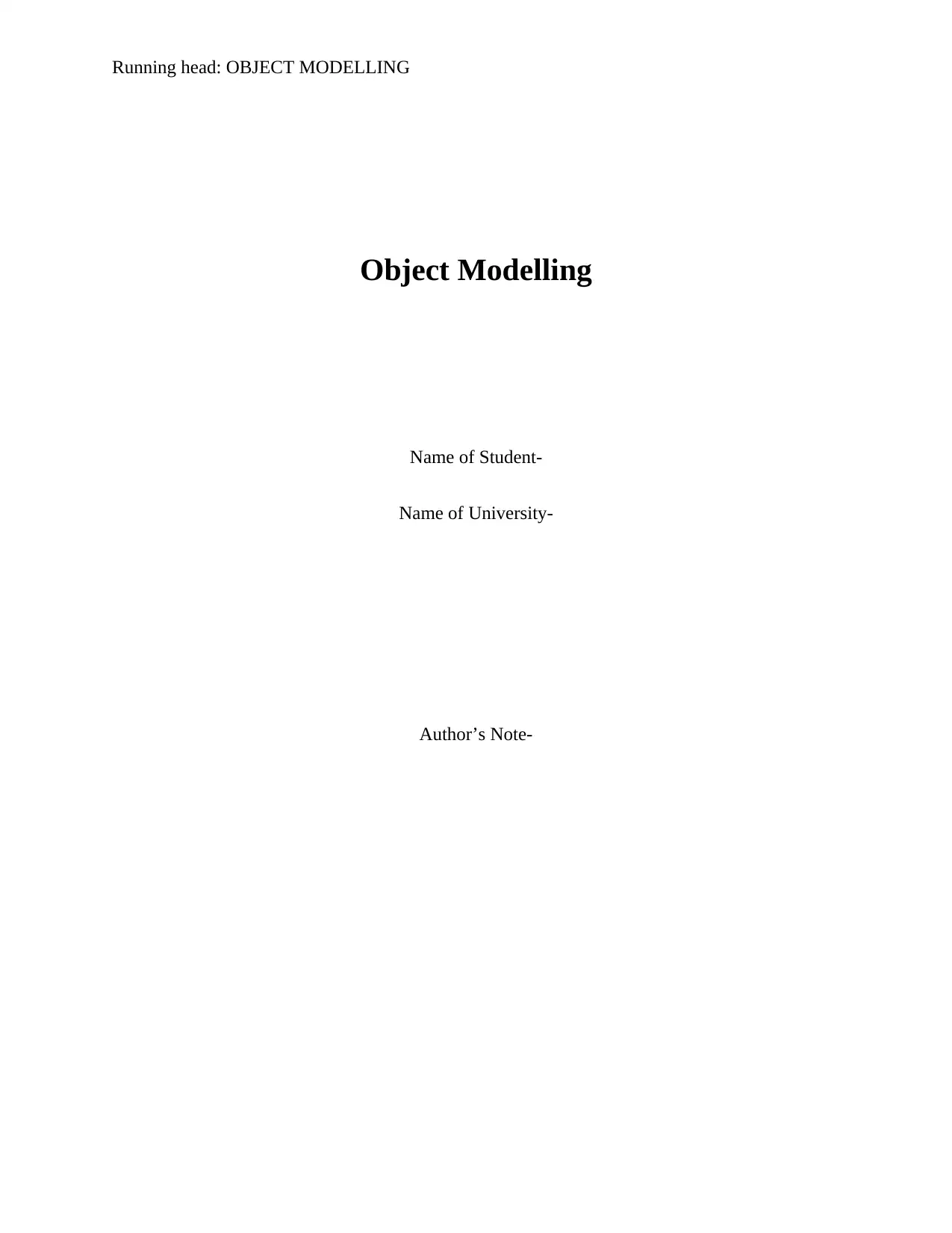
Running head: OBJECT MODELLING
Object Modelling
Name of Student-
Name of University-
Author’s Note-
Object Modelling
Name of Student-
Name of University-
Author’s Note-
Paraphrase This Document
Need a fresh take? Get an instant paraphrase of this document with our AI Paraphraser
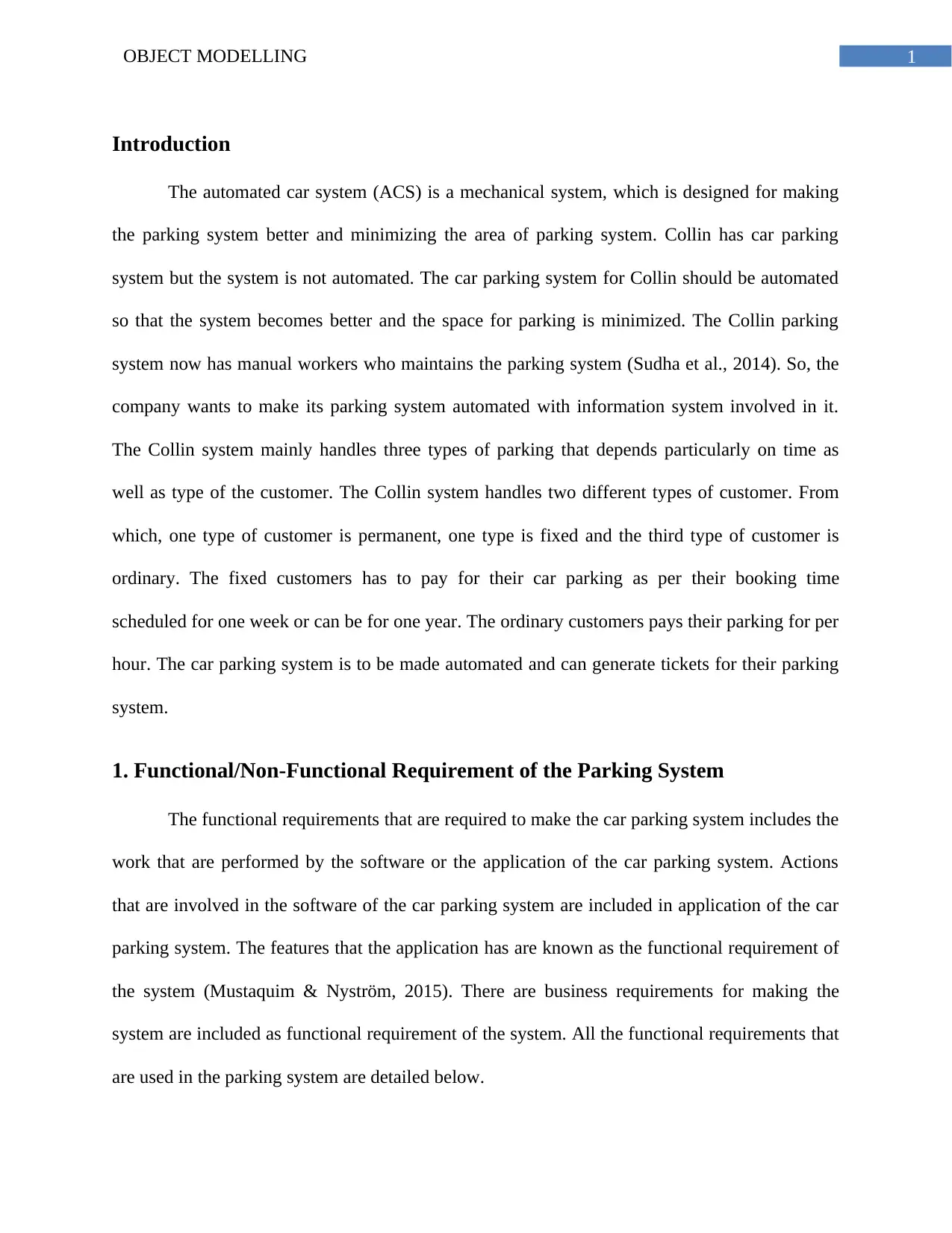
1OBJECT MODELLING
Introduction
The automated car system (ACS) is a mechanical system, which is designed for making
the parking system better and minimizing the area of parking system. Collin has car parking
system but the system is not automated. The car parking system for Collin should be automated
so that the system becomes better and the space for parking is minimized. The Collin parking
system now has manual workers who maintains the parking system (Sudha et al., 2014). So, the
company wants to make its parking system automated with information system involved in it.
The Collin system mainly handles three types of parking that depends particularly on time as
well as type of the customer. The Collin system handles two different types of customer. From
which, one type of customer is permanent, one type is fixed and the third type of customer is
ordinary. The fixed customers has to pay for their car parking as per their booking time
scheduled for one week or can be for one year. The ordinary customers pays their parking for per
hour. The car parking system is to be made automated and can generate tickets for their parking
system.
1. Functional/Non-Functional Requirement of the Parking System
The functional requirements that are required to make the car parking system includes the
work that are performed by the software or the application of the car parking system. Actions
that are involved in the software of the car parking system are included in application of the car
parking system. The features that the application has are known as the functional requirement of
the system (Mustaquim & Nyström, 2015). There are business requirements for making the
system are included as functional requirement of the system. All the functional requirements that
are used in the parking system are detailed below.
Introduction
The automated car system (ACS) is a mechanical system, which is designed for making
the parking system better and minimizing the area of parking system. Collin has car parking
system but the system is not automated. The car parking system for Collin should be automated
so that the system becomes better and the space for parking is minimized. The Collin parking
system now has manual workers who maintains the parking system (Sudha et al., 2014). So, the
company wants to make its parking system automated with information system involved in it.
The Collin system mainly handles three types of parking that depends particularly on time as
well as type of the customer. The Collin system handles two different types of customer. From
which, one type of customer is permanent, one type is fixed and the third type of customer is
ordinary. The fixed customers has to pay for their car parking as per their booking time
scheduled for one week or can be for one year. The ordinary customers pays their parking for per
hour. The car parking system is to be made automated and can generate tickets for their parking
system.
1. Functional/Non-Functional Requirement of the Parking System
The functional requirements that are required to make the car parking system includes the
work that are performed by the software or the application of the car parking system. Actions
that are involved in the software of the car parking system are included in application of the car
parking system. The features that the application has are known as the functional requirement of
the system (Mustaquim & Nyström, 2015). There are business requirements for making the
system are included as functional requirement of the system. All the functional requirements that
are used in the parking system are detailed below.
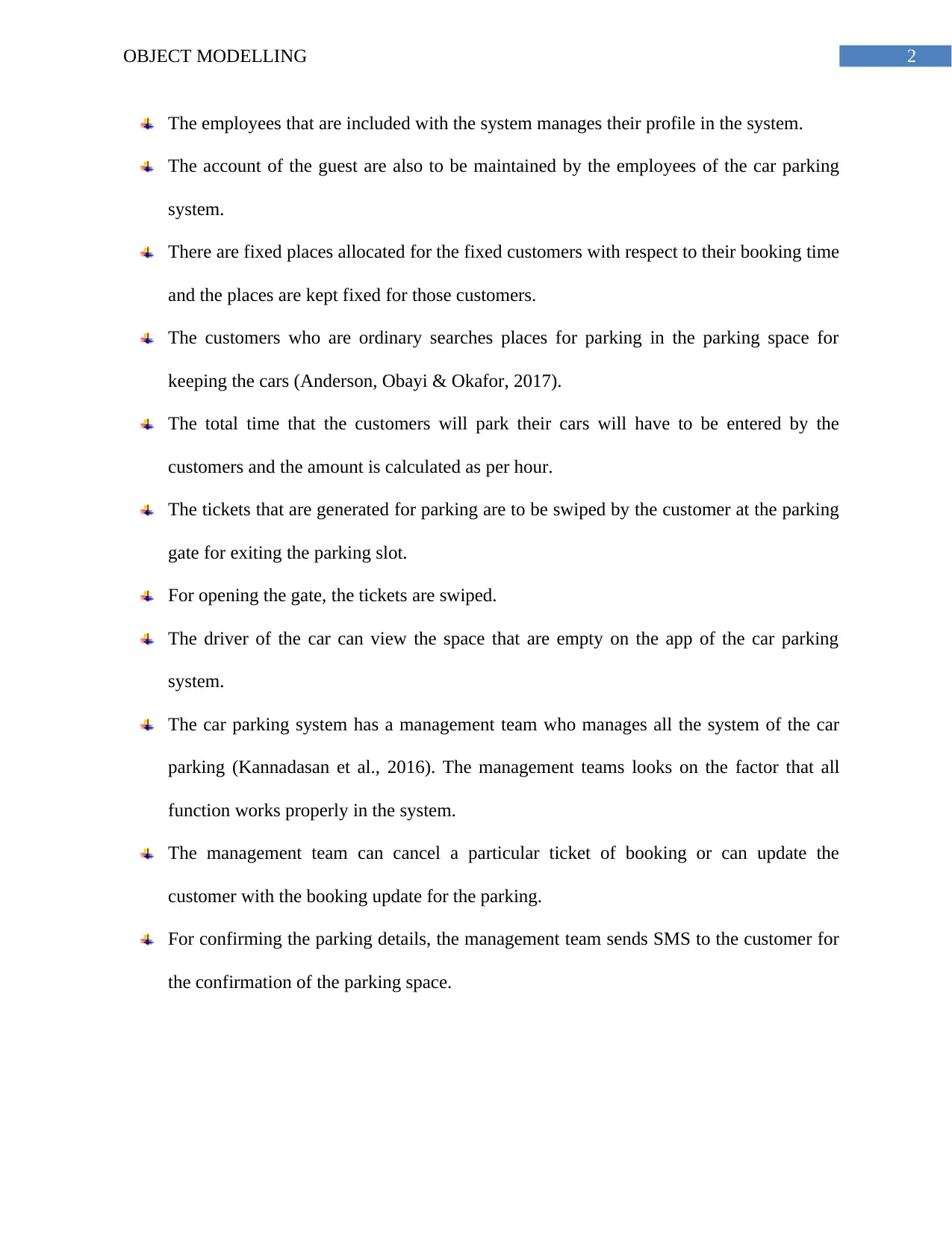
2OBJECT MODELLING
The employees that are included with the system manages their profile in the system.
The account of the guest are also to be maintained by the employees of the car parking
system.
There are fixed places allocated for the fixed customers with respect to their booking time
and the places are kept fixed for those customers.
The customers who are ordinary searches places for parking in the parking space for
keeping the cars (Anderson, Obayi & Okafor, 2017).
The total time that the customers will park their cars will have to be entered by the
customers and the amount is calculated as per hour.
The tickets that are generated for parking are to be swiped by the customer at the parking
gate for exiting the parking slot.
For opening the gate, the tickets are swiped.
The driver of the car can view the space that are empty on the app of the car parking
system.
The car parking system has a management team who manages all the system of the car
parking (Kannadasan et al., 2016). The management teams looks on the factor that all
function works properly in the system.
The management team can cancel a particular ticket of booking or can update the
customer with the booking update for the parking.
For confirming the parking details, the management team sends SMS to the customer for
the confirmation of the parking space.
The employees that are included with the system manages their profile in the system.
The account of the guest are also to be maintained by the employees of the car parking
system.
There are fixed places allocated for the fixed customers with respect to their booking time
and the places are kept fixed for those customers.
The customers who are ordinary searches places for parking in the parking space for
keeping the cars (Anderson, Obayi & Okafor, 2017).
The total time that the customers will park their cars will have to be entered by the
customers and the amount is calculated as per hour.
The tickets that are generated for parking are to be swiped by the customer at the parking
gate for exiting the parking slot.
For opening the gate, the tickets are swiped.
The driver of the car can view the space that are empty on the app of the car parking
system.
The car parking system has a management team who manages all the system of the car
parking (Kannadasan et al., 2016). The management teams looks on the factor that all
function works properly in the system.
The management team can cancel a particular ticket of booking or can update the
customer with the booking update for the parking.
For confirming the parking details, the management team sends SMS to the customer for
the confirmation of the parking space.
⊘ This is a preview!⊘
Do you want full access?
Subscribe today to unlock all pages.

Trusted by 1+ million students worldwide

3OBJECT MODELLING
The employees who are responsible for looking after the parking details, looks after
whether the cars are parked properly or not. The management user manages the system
properly.
The checkout for the vehicles are also registered by the user management.
The non-functional requirements that are included in the system is the properties that the
system involves. The work type or the character type that are involved with the system are
included in the non-functional requirement of the car parking system (Pham et al., 2015). The
experience of the user while using the car parking system are stated as the non-functional
requirements of the car parking system. The non-functional requirement of the system are
functions that makes the system fast, reliable, as well as makes the software attractive. The
characteristics and the qualities that the system possesses are defined as the non-functional
requirement of the system. All the non-functional requirement of the car parking system are
stated below.
The customers check empty space for parking in the parking space to keep their cars.
The customers are to communicate properly with customer for making the parking is the
parking system (Valacich, George & Hoffer, 2014).
There is a network that connects all the system internally. The communication cost for
the system network is actually high and the cost actually depends on the network that is
used by the car parking system.
There is to be a proper data structure for establishing a data storage in the system of the
software.
The interface that is to be used in between the user and the system is to be good enough
for proper communication.
The employees who are responsible for looking after the parking details, looks after
whether the cars are parked properly or not. The management user manages the system
properly.
The checkout for the vehicles are also registered by the user management.
The non-functional requirements that are included in the system is the properties that the
system involves. The work type or the character type that are involved with the system are
included in the non-functional requirement of the car parking system (Pham et al., 2015). The
experience of the user while using the car parking system are stated as the non-functional
requirements of the car parking system. The non-functional requirement of the system are
functions that makes the system fast, reliable, as well as makes the software attractive. The
characteristics and the qualities that the system possesses are defined as the non-functional
requirement of the system. All the non-functional requirement of the car parking system are
stated below.
The customers check empty space for parking in the parking space to keep their cars.
The customers are to communicate properly with customer for making the parking is the
parking system (Valacich, George & Hoffer, 2014).
There is a network that connects all the system internally. The communication cost for
the system network is actually high and the cost actually depends on the network that is
used by the car parking system.
There is to be a proper data structure for establishing a data storage in the system of the
software.
The interface that is to be used in between the user and the system is to be good enough
for proper communication.
Paraphrase This Document
Need a fresh take? Get an instant paraphrase of this document with our AI Paraphraser
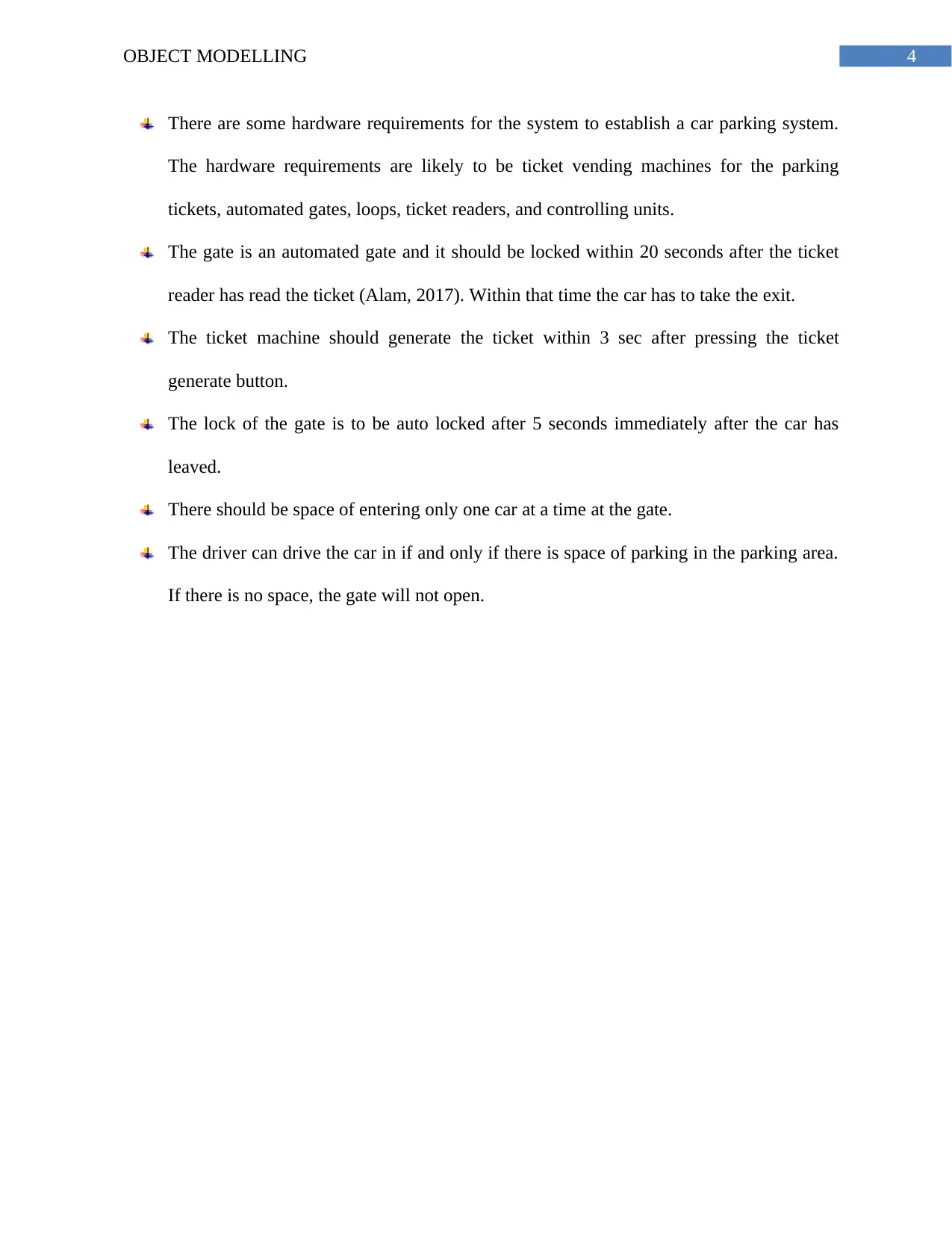
4OBJECT MODELLING
There are some hardware requirements for the system to establish a car parking system.
The hardware requirements are likely to be ticket vending machines for the parking
tickets, automated gates, loops, ticket readers, and controlling units.
The gate is an automated gate and it should be locked within 20 seconds after the ticket
reader has read the ticket (Alam, 2017). Within that time the car has to take the exit.
The ticket machine should generate the ticket within 3 sec after pressing the ticket
generate button.
The lock of the gate is to be auto locked after 5 seconds immediately after the car has
leaved.
There should be space of entering only one car at a time at the gate.
The driver can drive the car in if and only if there is space of parking in the parking area.
If there is no space, the gate will not open.
There are some hardware requirements for the system to establish a car parking system.
The hardware requirements are likely to be ticket vending machines for the parking
tickets, automated gates, loops, ticket readers, and controlling units.
The gate is an automated gate and it should be locked within 20 seconds after the ticket
reader has read the ticket (Alam, 2017). Within that time the car has to take the exit.
The ticket machine should generate the ticket within 3 sec after pressing the ticket
generate button.
The lock of the gate is to be auto locked after 5 seconds immediately after the car has
leaved.
There should be space of entering only one car at a time at the gate.
The driver can drive the car in if and only if there is space of parking in the parking area.
If there is no space, the gate will not open.
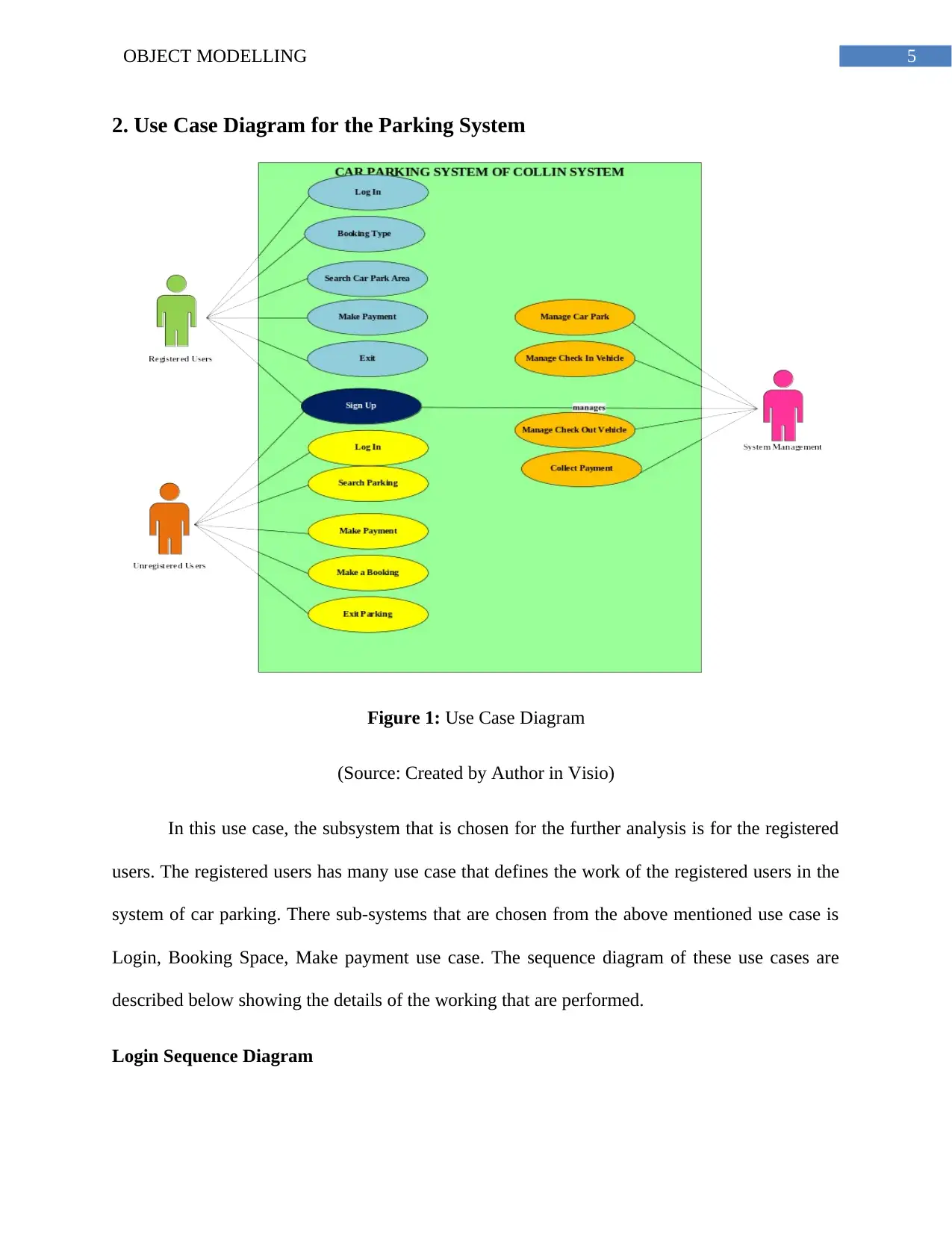
5OBJECT MODELLING
2. Use Case Diagram for the Parking System
Figure 1: Use Case Diagram
(Source: Created by Author in Visio)
In this use case, the subsystem that is chosen for the further analysis is for the registered
users. The registered users has many use case that defines the work of the registered users in the
system of car parking. There sub-systems that are chosen from the above mentioned use case is
Login, Booking Space, Make payment use case. The sequence diagram of these use cases are
described below showing the details of the working that are performed.
Login Sequence Diagram
2. Use Case Diagram for the Parking System
Figure 1: Use Case Diagram
(Source: Created by Author in Visio)
In this use case, the subsystem that is chosen for the further analysis is for the registered
users. The registered users has many use case that defines the work of the registered users in the
system of car parking. There sub-systems that are chosen from the above mentioned use case is
Login, Booking Space, Make payment use case. The sequence diagram of these use cases are
described below showing the details of the working that are performed.
Login Sequence Diagram
⊘ This is a preview!⊘
Do you want full access?
Subscribe today to unlock all pages.

Trusted by 1+ million students worldwide
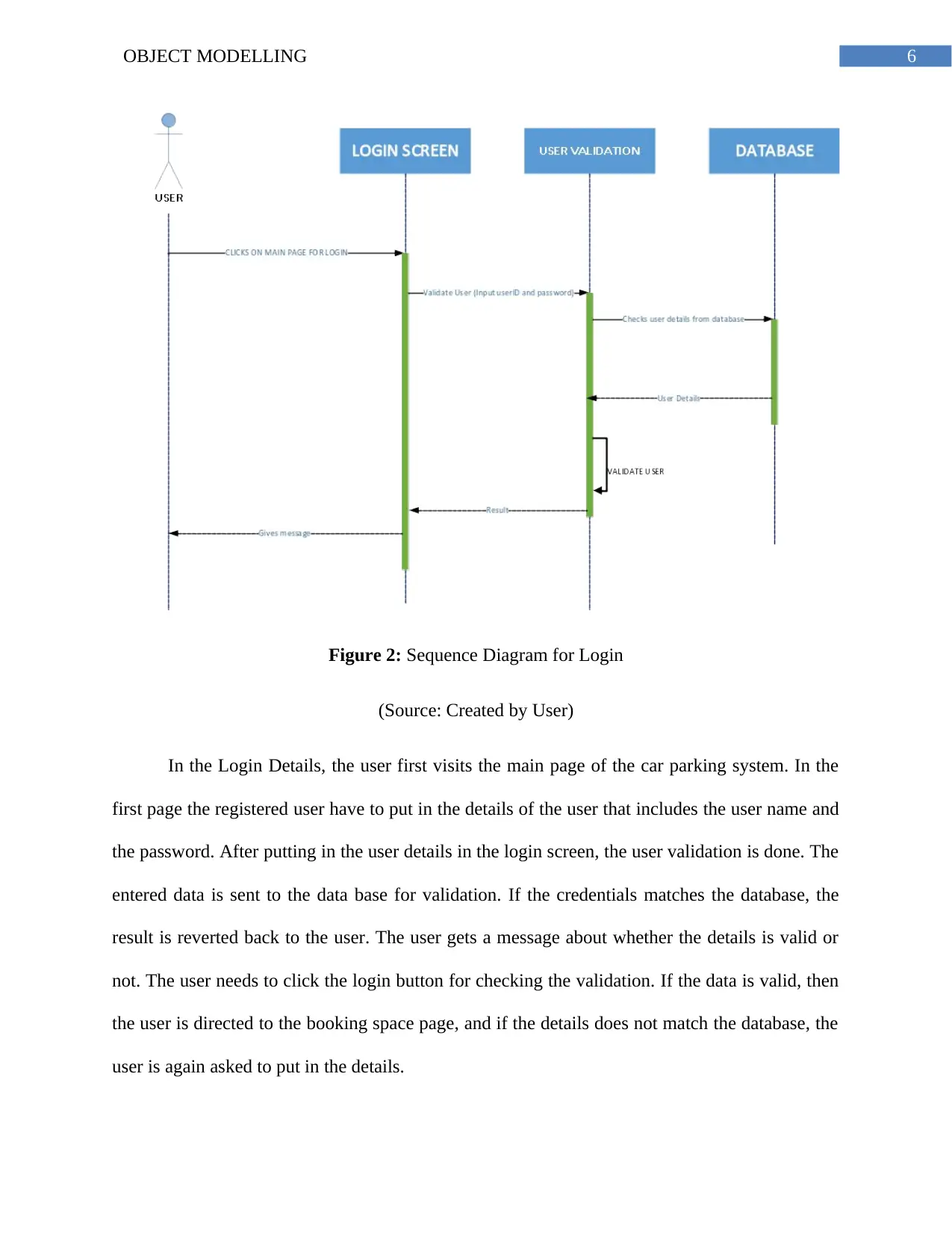
6OBJECT MODELLING
Figure 2: Sequence Diagram for Login
(Source: Created by User)
In the Login Details, the user first visits the main page of the car parking system. In the
first page the registered user have to put in the details of the user that includes the user name and
the password. After putting in the user details in the login screen, the user validation is done. The
entered data is sent to the data base for validation. If the credentials matches the database, the
result is reverted back to the user. The user gets a message about whether the details is valid or
not. The user needs to click the login button for checking the validation. If the data is valid, then
the user is directed to the booking space page, and if the details does not match the database, the
user is again asked to put in the details.
Figure 2: Sequence Diagram for Login
(Source: Created by User)
In the Login Details, the user first visits the main page of the car parking system. In the
first page the registered user have to put in the details of the user that includes the user name and
the password. After putting in the user details in the login screen, the user validation is done. The
entered data is sent to the data base for validation. If the credentials matches the database, the
result is reverted back to the user. The user gets a message about whether the details is valid or
not. The user needs to click the login button for checking the validation. If the data is valid, then
the user is directed to the booking space page, and if the details does not match the database, the
user is again asked to put in the details.
Paraphrase This Document
Need a fresh take? Get an instant paraphrase of this document with our AI Paraphraser

7OBJECT MODELLING
Booking Space Sequence Diagram
Figure 3: Sequence Diagram for Booking Space
(Source: Created by User)
For checking the booking space details, from the main page the customer will have to
check for space in the parking area whether there is space or not. If there is availability of space,
then the request will be directed to the technician who is involved with the system. The
technician enquiries whether the space is available and the parking is possible or not. If the space
is ok for parking, then the customer gets a message that the space is allocated to the user. And if
there is no space available, then the user is prompted with a message that choose another space
for parking. The customer will get the alert on the display which he is using for booking.
Make Payment Sequence Diagram
Booking Space Sequence Diagram
Figure 3: Sequence Diagram for Booking Space
(Source: Created by User)
For checking the booking space details, from the main page the customer will have to
check for space in the parking area whether there is space or not. If there is availability of space,
then the request will be directed to the technician who is involved with the system. The
technician enquiries whether the space is available and the parking is possible or not. If the space
is ok for parking, then the customer gets a message that the space is allocated to the user. And if
there is no space available, then the user is prompted with a message that choose another space
for parking. The customer will get the alert on the display which he is using for booking.
Make Payment Sequence Diagram
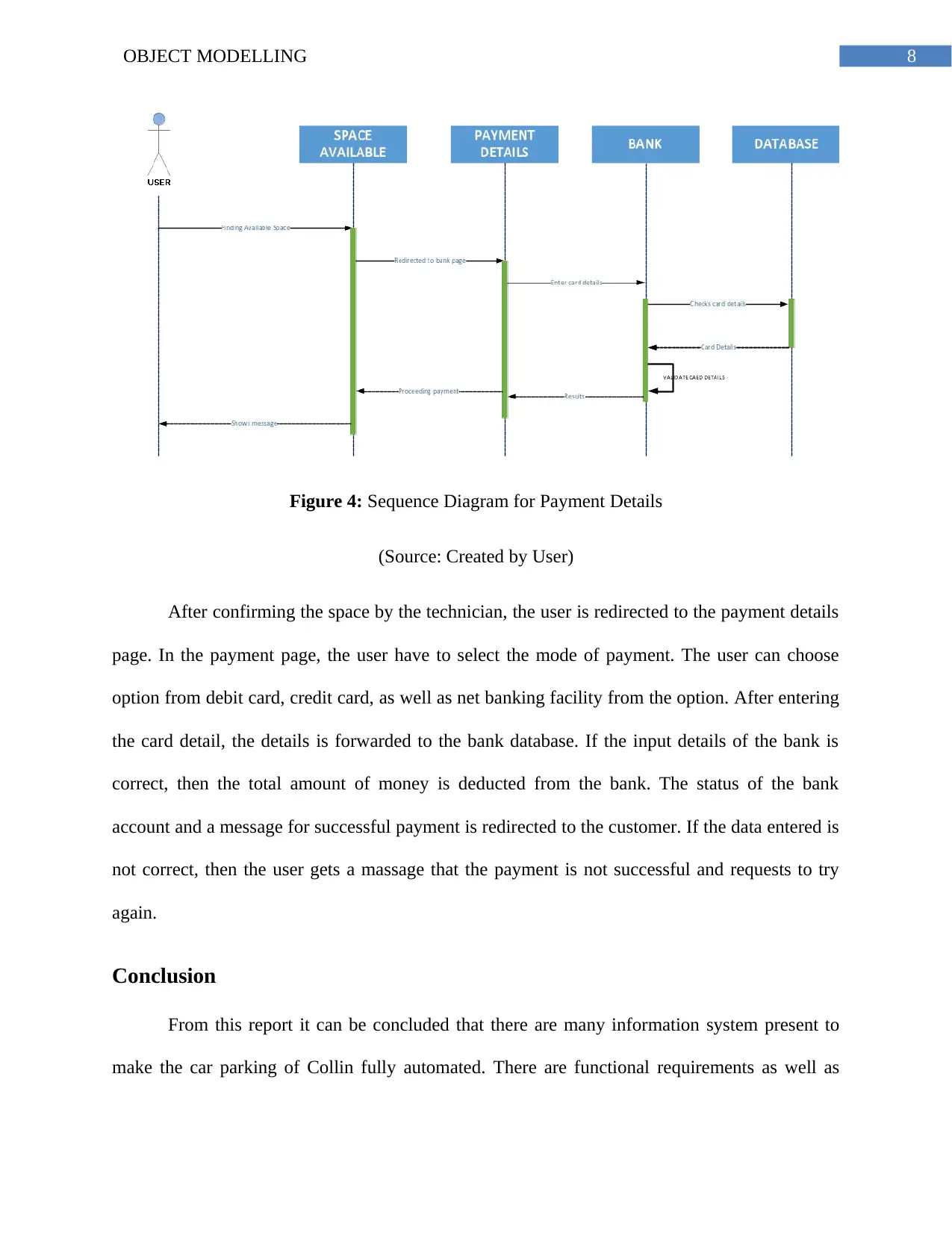
8OBJECT MODELLING
Figure 4: Sequence Diagram for Payment Details
(Source: Created by User)
After confirming the space by the technician, the user is redirected to the payment details
page. In the payment page, the user have to select the mode of payment. The user can choose
option from debit card, credit card, as well as net banking facility from the option. After entering
the card detail, the details is forwarded to the bank database. If the input details of the bank is
correct, then the total amount of money is deducted from the bank. The status of the bank
account and a message for successful payment is redirected to the customer. If the data entered is
not correct, then the user gets a massage that the payment is not successful and requests to try
again.
Conclusion
From this report it can be concluded that there are many information system present to
make the car parking of Collin fully automated. There are functional requirements as well as
Figure 4: Sequence Diagram for Payment Details
(Source: Created by User)
After confirming the space by the technician, the user is redirected to the payment details
page. In the payment page, the user have to select the mode of payment. The user can choose
option from debit card, credit card, as well as net banking facility from the option. After entering
the card detail, the details is forwarded to the bank database. If the input details of the bank is
correct, then the total amount of money is deducted from the bank. The status of the bank
account and a message for successful payment is redirected to the customer. If the data entered is
not correct, then the user gets a massage that the payment is not successful and requests to try
again.
Conclusion
From this report it can be concluded that there are many information system present to
make the car parking of Collin fully automated. There are functional requirements as well as
⊘ This is a preview!⊘
Do you want full access?
Subscribe today to unlock all pages.

Trusted by 1+ million students worldwide

9OBJECT MODELLING
non- functional requirements that are required for the car parking system of Collin that were
explained in this report. From all the uses cases in the use case diagram, the subsystem of the
registered user is chosen for carrying out further analysis. The registered users shows many use
case that defines the work of the registered users in the system of car parking. From there sub-
systems that are chosen from the use case is Login, Booking Space, Make payment use case. The
sequence diagram of these use cases are explained in this report in details.
non- functional requirements that are required for the car parking system of Collin that were
explained in this report. From all the uses cases in the use case diagram, the subsystem of the
registered user is chosen for carrying out further analysis. The registered users shows many use
case that defines the work of the registered users in the system of car parking. From there sub-
systems that are chosen from the use case is Login, Booking Space, Make payment use case. The
sequence diagram of these use cases are explained in this report in details.
Paraphrase This Document
Need a fresh take? Get an instant paraphrase of this document with our AI Paraphraser
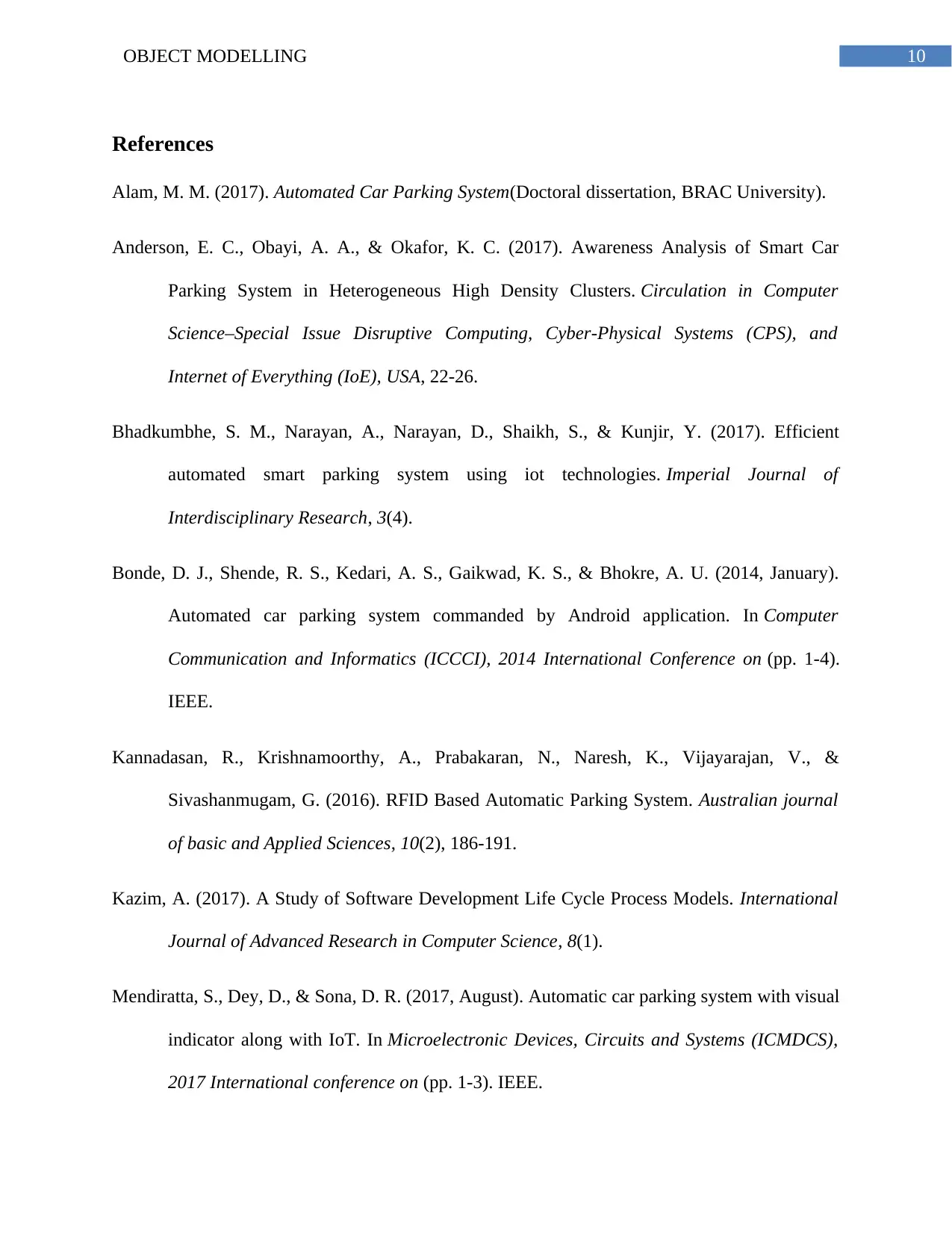
10OBJECT MODELLING
References
Alam, M. M. (2017). Automated Car Parking System(Doctoral dissertation, BRAC University).
Anderson, E. C., Obayi, A. A., & Okafor, K. C. (2017). Awareness Analysis of Smart Car
Parking System in Heterogeneous High Density Clusters. Circulation in Computer
Science–Special Issue Disruptive Computing, Cyber-Physical Systems (CPS), and
Internet of Everything (IoE), USA, 22-26.
Bhadkumbhe, S. M., Narayan, A., Narayan, D., Shaikh, S., & Kunjir, Y. (2017). Efficient
automated smart parking system using iot technologies. Imperial Journal of
Interdisciplinary Research, 3(4).
Bonde, D. J., Shende, R. S., Kedari, A. S., Gaikwad, K. S., & Bhokre, A. U. (2014, January).
Automated car parking system commanded by Android application. In Computer
Communication and Informatics (ICCCI), 2014 International Conference on (pp. 1-4).
IEEE.
Kannadasan, R., Krishnamoorthy, A., Prabakaran, N., Naresh, K., Vijayarajan, V., &
Sivashanmugam, G. (2016). RFID Based Automatic Parking System. Australian journal
of basic and Applied Sciences, 10(2), 186-191.
Kazim, A. (2017). A Study of Software Development Life Cycle Process Models. International
Journal of Advanced Research in Computer Science, 8(1).
Mendiratta, S., Dey, D., & Sona, D. R. (2017, August). Automatic car parking system with visual
indicator along with IoT. In Microelectronic Devices, Circuits and Systems (ICMDCS),
2017 International conference on (pp. 1-3). IEEE.
References
Alam, M. M. (2017). Automated Car Parking System(Doctoral dissertation, BRAC University).
Anderson, E. C., Obayi, A. A., & Okafor, K. C. (2017). Awareness Analysis of Smart Car
Parking System in Heterogeneous High Density Clusters. Circulation in Computer
Science–Special Issue Disruptive Computing, Cyber-Physical Systems (CPS), and
Internet of Everything (IoE), USA, 22-26.
Bhadkumbhe, S. M., Narayan, A., Narayan, D., Shaikh, S., & Kunjir, Y. (2017). Efficient
automated smart parking system using iot technologies. Imperial Journal of
Interdisciplinary Research, 3(4).
Bonde, D. J., Shende, R. S., Kedari, A. S., Gaikwad, K. S., & Bhokre, A. U. (2014, January).
Automated car parking system commanded by Android application. In Computer
Communication and Informatics (ICCCI), 2014 International Conference on (pp. 1-4).
IEEE.
Kannadasan, R., Krishnamoorthy, A., Prabakaran, N., Naresh, K., Vijayarajan, V., &
Sivashanmugam, G. (2016). RFID Based Automatic Parking System. Australian journal
of basic and Applied Sciences, 10(2), 186-191.
Kazim, A. (2017). A Study of Software Development Life Cycle Process Models. International
Journal of Advanced Research in Computer Science, 8(1).
Mendiratta, S., Dey, D., & Sona, D. R. (2017, August). Automatic car parking system with visual
indicator along with IoT. In Microelectronic Devices, Circuits and Systems (ICMDCS),
2017 International conference on (pp. 1-3). IEEE.
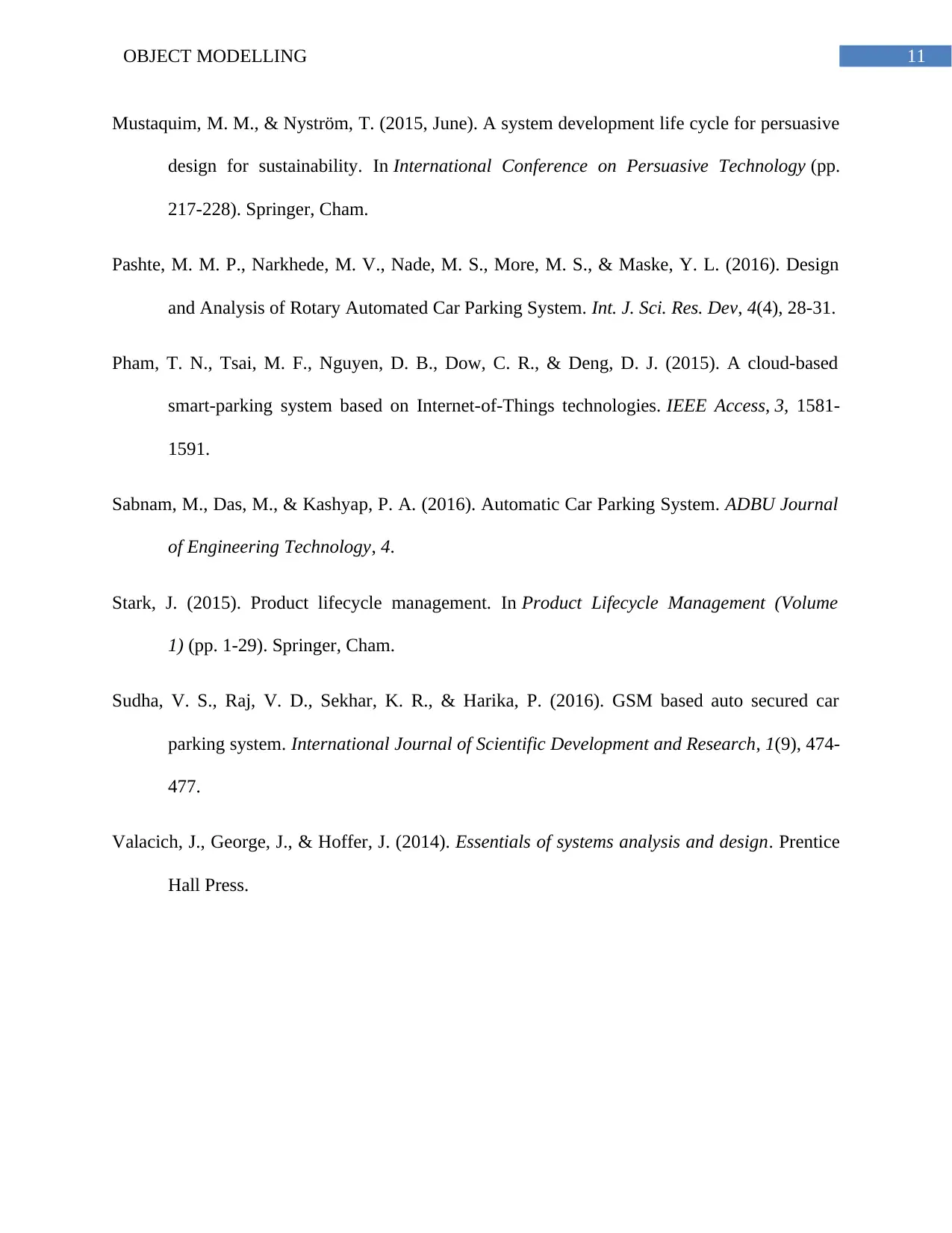
11OBJECT MODELLING
Mustaquim, M. M., & Nyström, T. (2015, June). A system development life cycle for persuasive
design for sustainability. In International Conference on Persuasive Technology (pp.
217-228). Springer, Cham.
Pashte, M. M. P., Narkhede, M. V., Nade, M. S., More, M. S., & Maske, Y. L. (2016). Design
and Analysis of Rotary Automated Car Parking System. Int. J. Sci. Res. Dev, 4(4), 28-31.
Pham, T. N., Tsai, M. F., Nguyen, D. B., Dow, C. R., & Deng, D. J. (2015). A cloud-based
smart-parking system based on Internet-of-Things technologies. IEEE Access, 3, 1581-
1591.
Sabnam, M., Das, M., & Kashyap, P. A. (2016). Automatic Car Parking System. ADBU Journal
of Engineering Technology, 4.
Stark, J. (2015). Product lifecycle management. In Product Lifecycle Management (Volume
1) (pp. 1-29). Springer, Cham.
Sudha, V. S., Raj, V. D., Sekhar, K. R., & Harika, P. (2016). GSM based auto secured car
parking system. International Journal of Scientific Development and Research, 1(9), 474-
477.
Valacich, J., George, J., & Hoffer, J. (2014). Essentials of systems analysis and design. Prentice
Hall Press.
Mustaquim, M. M., & Nyström, T. (2015, June). A system development life cycle for persuasive
design for sustainability. In International Conference on Persuasive Technology (pp.
217-228). Springer, Cham.
Pashte, M. M. P., Narkhede, M. V., Nade, M. S., More, M. S., & Maske, Y. L. (2016). Design
and Analysis of Rotary Automated Car Parking System. Int. J. Sci. Res. Dev, 4(4), 28-31.
Pham, T. N., Tsai, M. F., Nguyen, D. B., Dow, C. R., & Deng, D. J. (2015). A cloud-based
smart-parking system based on Internet-of-Things technologies. IEEE Access, 3, 1581-
1591.
Sabnam, M., Das, M., & Kashyap, P. A. (2016). Automatic Car Parking System. ADBU Journal
of Engineering Technology, 4.
Stark, J. (2015). Product lifecycle management. In Product Lifecycle Management (Volume
1) (pp. 1-29). Springer, Cham.
Sudha, V. S., Raj, V. D., Sekhar, K. R., & Harika, P. (2016). GSM based auto secured car
parking system. International Journal of Scientific Development and Research, 1(9), 474-
477.
Valacich, J., George, J., & Hoffer, J. (2014). Essentials of systems analysis and design. Prentice
Hall Press.
⊘ This is a preview!⊘
Do you want full access?
Subscribe today to unlock all pages.

Trusted by 1+ million students worldwide
1 out of 12
Related Documents
Your All-in-One AI-Powered Toolkit for Academic Success.
+13062052269
info@desklib.com
Available 24*7 on WhatsApp / Email
![[object Object]](/_next/static/media/star-bottom.7253800d.svg)
Unlock your academic potential
Copyright © 2020–2025 A2Z Services. All Rights Reserved. Developed and managed by ZUCOL.





